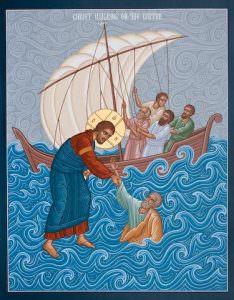Water walking
At the fourth watch of the night he came wandering towards them on the sea. But when the disciples saw him, they were terrified, saying “It is a ghost!” And they cried out. But immediately Jesus spoke to them and said, “Take heart, it is I; do not be afraid” (Mt 14)
1.
We hear another “sea miracle,” as they are sometimes called–the second in Matthew’s gospel.
You will know that, earlier in this gospel, Jesus calms the raging seas. The water is washing and churning and filling up the ship. His disciples are terrified. Yet Jesus himself is sound asleep in the stern, untroubled. 
“Master, we are sinking; don’t you care?” they cry out.
And waking, Jesus says, “O you of little trust!”
“Be still!” he bellows at the turbulent sea. In fact his words literally mean “be muzzled!”: his voice subdues their monstrous and demonic force. The waters of chaos are subdued. It is as if he has bound that ancient sea-monster, Leviathan, who, according to Jewish tradition, thrashes in the deep, casting up all sorts of disorder and spiritual disturbance.
Our episode is very similar.
Jesus comes to the disciples after a long time of prayer, something perhaps like an ecstatic trance—for it went all night, from early evening until the cold of the pre-dawn.
He comes to them wandering on the seas; and they perceive him as something like a vision, a phantasm (phantasma): they think they have seen a ghost. And his ethereality, his lightness, offers us a clue to the meaning of this event. Jesus is, it seems, something like the Spirit of God, who, at the first creation, hovered over the waters when all the earth was formless and void. The Spirit of God, we hear in Genesis, moved over the dark and primordial waters, just before first light—the first light that ever was. And suddenly order emerges from the chaos; form from formlessness.
So too in our episode. The fierce winds blow—the winds of chaos, beating against the ship; but Jesus comes to bring all things to order.
“Be not afraid, I AM!” he says: or, as our texts have it in more natural English, “be not afraid, it is I”. But the I AM is important, for it is the Holy Name of God, which was, you will recall, revealed to Moses on Mt Sinai. God is the great I AM.
Jesus, moving so lightly, so ethereally, is a divine presence over the void.
2.
And Peter steps out in trust to meet him.
He steps out over the void, over the formlessness. Doesn’t this have a real emotional significance? It is as if the abyss below his feet is a dark place of meaninglessness, a place for sea-monsters. I am sure we can imagine ourselves into Peter’s shoes; we have been there ourselves. We sometimes find ourselves trying to walk, uncomfortably, over a dark and menacing abyss. We do not know how to cope, how we will put one foot in front of the other. Nothing seems to make sense. There is no meaning, no order.
So we lose heart. Our trust fails us and, like Peter, we begin to sink down and down. Like Peter we cry out, “Lord, Save me!”
Indeed, Peter cries out in the voice of a psalm:
Save me, O God, for the waters are come in, even unto my soul: I stick fast in the deep mire, where no ground is: I am come into deep waters, so that the floods run over me.
Take me out of the mire, that I sink not: O let me be delivered from them that hate me, and out of the deep waters. Let not the water-flood drown me, neither let the deep swallow me up: and let not the pit shut her mouth upon me. (Ps 69)
So sings the psalmist, in the sixty-ninth psalm.
“O you of little trust, why do you hesitate?” asks Jesus.
Have trust. It is trust which will save us from meaninglessness, from sinking into the depths. We have trust, that though the way is difficult and uncertain, we will by God’s providence survive and make it to solid ground. All will be well. Even our sufferings will be turned to good if we trust in God.
For God is the Meaning over the void; and when we turn to God we seek out the meaningfulness in every situation. Even where we cannot see any meaning, we trust that there is one just beyond our understanding. And little by little we try to discern the great meaning, the meaning of our lives, the purpose that God is speaking into our disorder. We trust in God; and our feet are kept from falling.
3.
Jesus steps onto the ship-deck, bringing Peter with him. The ship is a symbol for the Church, so one ancient theologian tells us (Theophylact).
Indeed, the Church has always been likened to a ship. It is an ark of humanity, carrying us over the choppy seas and sheltering us against the strong winds. If you look at the ceiling of many churches, you will see they are like the upturned hull of a ship with joints and ribs; and the central aisle is called the nave—from the Latin navis, ship. When infants were baptised in our Church until recent times, the priest prayed that he or she “be received into the ark of Christ’s Church; and being steadfast in faith, joyful through hope, and rooted in charity, may so pass the waves of this troublesome world, that finally [he or she] may come to the land of everlasting life…” (BCP, Publick Baptism of Infants)
Jesus steps onto the ship-deck. And, see, the winds die down: the hard rowing is at an end. Soon we will hoist our sail again. So we bow down and worship this Jesus as the Son of God. Yes, we, like the apostles, are afloat on the seas of life; but we are kept from sinking or drowning, for here is our helmsman, Jesus Christ.
May we always look to Jesus, who saves us from the storms of life—to him who has promised to be with us always, even to the end of the age.
Amen.


